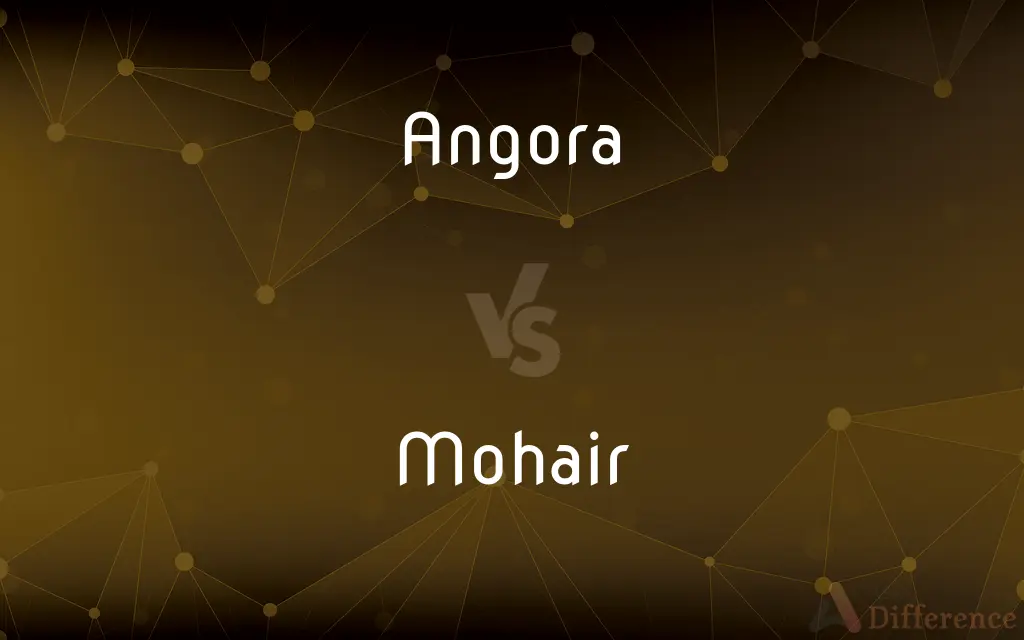Angora vs. Mohair — What's the Difference?
By Tayyaba Rehman & Fiza Rafique — Updated on April 21, 2024
"Angora" refers to fibers from the fur of Angora rabbits, characterized by softness and fluffiness, while "mohair" comes from the hair of Angora goats, known for its luster and strength.

Difference Between Angora and Mohair
Table of Contents
ADVERTISEMENT
Key Differences
"Angora" fibers are derived from Angora rabbits, producing a very soft, fine, and fluffy wool, whereas "mohair" fibers, sourced from Angora goats, are distinguished by their sheen and durability.
Angora wool is highly prized for its warmth and is often used in luxury winter wear, while mohair, due to its strength and elasticity, is frequently used in both summer and winter garments.
The texture of Angora wool is extremely soft to the touch, making it ideal for delicate items like baby clothes and lightweight sweaters, whereas mohair has a silkier texture, suitable for items that require more structure, such as coats and suits.
Angora products tend to shed more due to the finer hairs, which can lead to pilling, while mohair's smoother fibers make it more resistant to shedding and pilling.
The production of Angora wool is often surrounded by ethical concerns regarding the treatment of rabbits, leading some manufacturers to seek certified humane sources; mohair production, while also scrutinized, typically involves shearing goats without harming them.
ADVERTISEMENT
Comparison Chart
Source Animal
Angora rabbit
Angora goat
Fiber Texture
Soft, fluffy
Silky, lustrous
Common Use
Winter wear, baby clothes
Suits, coats, summer and winter wear
Durability
Less durable, prone to pilling
Durable, resistant to pilling
Ethical Concerns
High, due to potential mistreatment
Moderate, concerns about shearing practices
Compare with Definitions
Angora
Prone to shedding.
Her Angora scarf left fibers on her coat.
Mohair
Derived from goats.
The designer used mohair for the fall collection.
Angora
Known for fluffiness.
She chose an Angora blend for the baby's blanket.
Mohair
Lustrous and silky.
The mohair blend gave the fabric a subtle sheen.
Angora
Derived from rabbits.
The sweater was made of Angora for its unmatched softness.
Mohair
Less ethical concerns.
The mohair was sourced from a farm known for its ethical practices.
Angora
Warm and lightweight.
His Angora hat kept him warm all winter.
Mohair
Elastic and strong.
Mohair socks are both comfortable and durable.
Angora
Ethically controversial.
They only buy Angora from certified humane sources.
Mohair
Suitable for various garments.
His mohair suit was perfect for both formal and casual wear.
Angora
The hair of the Angora goat or of the Angora rabbit. Also called Angora wool.
Mohair
Mohair (pronounced ) is a fabric or yarn made from the hair of the Angora goat (not to be confused with the Angora rabbit, which produces Angora wool). Both durable and resilient, mohair is notable for its high luster and sheen, and is often used in fiber blends to add these qualities to a textile.
Angora
A yarn or fabric made from either of these kinds of hair.
Mohair
The long silky hair of the Angora goat.
Angora
An Angora cat.
Mohair
Fabric or yarn made from this hair.
Angora
An Angora goat.
Mohair
Yarn or fabric made from the hair of the angora goat, often as mixed with cotton or other materials.
Angora
An Angora rabbit.
Mohair
The long, fine hair of the Angora goat.
Angora
A Turkish Angora cat.
Mohair
An Angora goat.
Angora
A goat of a domesticated breed that produces mohair.
Mohair
The long silky hair or wool of the Angora goat of Asia Minor; also, a fabric made from this material, or an imitation of such fabric.
Angora
A rabbit belonging to the Angora rabbit breed, one of the oldest domestic breeds of rabbits in the world, raised chiefly in Europe for its silky and long hair Oryctolagus cuniculus}}
Mohair
Fabric made with yarn made from the silky hair of the Angora goat
Angora
(uncountable) The hair of angora rabbits or angora goats, used to make textiles.
Angora
(uncountable) The fabric made from the hair of angora rabbits or angora goats.
Angora
A city of Asia Minor (or Anatolia) which has given its name to a goat, a cat, etc.
Angora
Raised for its long silky hair which is the true mohair
Angora
Domestic breed with long white silky hair
Angora
A long-haired breed similar to the Persian cat
Common Curiosities
What animals produce Angora and mohair
Angora is produced by rabbits, and mohair by goats.
Which fiber is softer, Angora or mohair
Angora is softer than mohair.
How are Angora and mohair harvested
Angora is collected from rabbits, and mohair is sheared from goats.
Are there ethical concerns with Angora production
Yes, due to potential mistreatment of rabbits.
Why is mohair preferred for structured garments
Its strength and elasticity lend structure to garments.
Does Angora always involve animal harm
Not always, but ethical sourcing is crucial.
Can mohair garments be lightweight
Yes, mohair can be woven into lightweight fabrics.
Are there hypoallergenic options for Angora or mohair
Both can be allergenic; hypoallergenic treatments are recommended.
Is Angora suitable for people with sensitive skin
Yes, due to its extreme softness.
Can mohair be used for summer clothing
Yes, mohair's properties make it suitable for both summer and winter wear.
What is a common use for Angora wool
It is commonly used in luxury winter wear and delicate items.
Which is more durable, Angora or mohair
Mohair is more durable and resistant to pilling than Angora.
What ethical certifications should be considered for mohair
Certifications that ensure humane treatment of goats.
How does the luster of mohair compare to Angora
Mohair is more lustrous than Angora.
Share Your Discovery

Previous Comparison
Aguacate vs. Avocado
Next Comparison
Hint vs. ClueAuthor Spotlight
Written by
Tayyaba RehmanTayyaba Rehman is a distinguished writer, currently serving as a primary contributor to askdifference.com. As a researcher in semantics and etymology, Tayyaba's passion for the complexity of languages and their distinctions has found a perfect home on the platform. Tayyaba delves into the intricacies of language, distinguishing between commonly confused words and phrases, thereby providing clarity for readers worldwide.
Co-written by
Fiza RafiqueFiza Rafique is a skilled content writer at AskDifference.com, where she meticulously refines and enhances written pieces. Drawing from her vast editorial expertise, Fiza ensures clarity, accuracy, and precision in every article. Passionate about language, she continually seeks to elevate the quality of content for readers worldwide.













































